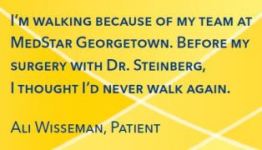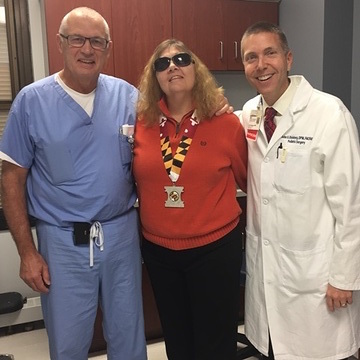Find care now
If you are experiencing a medical emergency, please call 911 or seek care at an emergency room.

By Heidi Rosvold-Brenholtz
For 21 years, Ali Wisseman had type 1 diabetes. A kidney and pancreas transplant in 2009 cured her condition, but she still battles many of the chronic effects of diabetes, such as nerve pain and poor circulation, blurred vision and foot ulcers. The medication she takes to support her transplant also makes her susceptible to infection. The deep wound on her right heel caused such severe pain that the 54-year-old dispatcher from Reston, Va., was nearly bedridden.
“I had absolutely no quality of life,” Ali says. “My physician told me my only option was to have my foot amputated. That’s when I went to the Center for Wound Healing at MedStar Georgetown University Hospital for a second opinion.”
Thanks to a new surgical technique developed by podiatric and plastic surgeons at MedStar Georgetown, Ali was spared from having her lower leg amputated. The innovative procedure, called a vertical contour calcanectomy, got Ali back on her feet again.
The surgical approach used to treat Ali’s heel infection and save her foot solves a major problem associated with traditional heel surgery, according to John S. Steinberg, DPM, FACFAS, chief of Podiatric Surgery and co-director of the Center for Wound Healing. “The traditional surgical approach often doesn’t leave enough soft tissue on the heel to withstand bone pressure from walking or standing,” he explains. New wounds can develop from the pressure and lead to bone infection, repeat surgery and a significantly increased risk for amputation.
“The advantage of the vertical contour calcanectomy is that we can construct a padded and contoured flap from the tissue remaining after the bulk of the bone is removed,” says Dr. Steinberg. “We then can close the wound with the patient’s own tissue without the need for an artificial tissue graft. This repair can withstand a lot of weight because it is stronger and sufficient bone is removed to create a new walking surface of the heel.” Another advantage is that there is minimal loss of height thanks to the contour created with the heel bone. “We’ve had remarkable results in patients who otherwise would face a below-the-knee amputation,” he adds.

“Ali’s case was complicated because of her medical history and the size of her wound,” says Dr.Steinberg. She’s typical of the type of patient often referred to the Center for Wound Healing. He credits a team approach for her recovery. Full-time physicians dedicated to limb salvage, surgery, infectious disease and vascular surgery are part of the treatment team for patients like Ali.
“I’m walking because of my team at MedStar Georgetown. Before my surgery with Dr. Steinberg, I thought I’d never walk again,” says Ali. In fact, she’s running. A running enthusiast throughout her life, in November 2016, Ali completed the Across the Bay 10K. “I walked a lot of it, but I finished, and now I’m hitting 18,000 walking steps a day. It’s a miracle.”
To show her gratitude, Ali presented her race medal to Dr. Steinberg and fellow wound care specialist Christopher Attinger, MD. “They earned it,” she says.
Learn More
For more information about services at the Center for Wound Healing, visit MedStarGeorgetown.org/WoundCare or call 202-295-0551.














